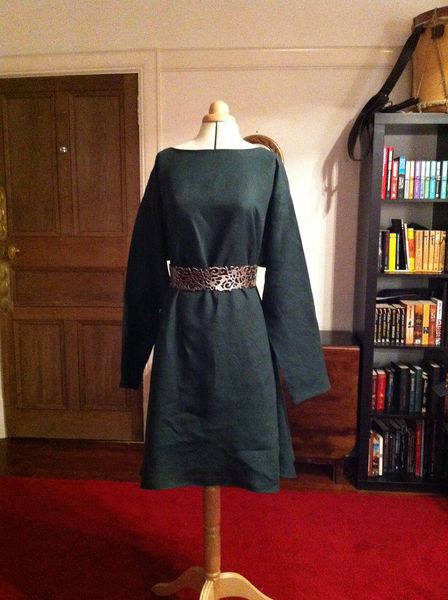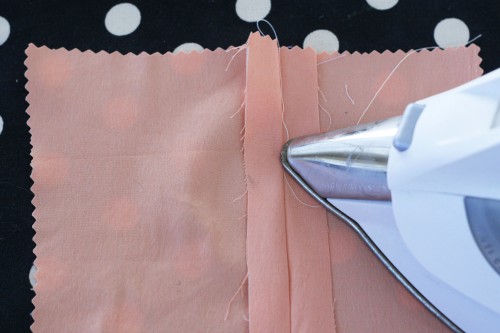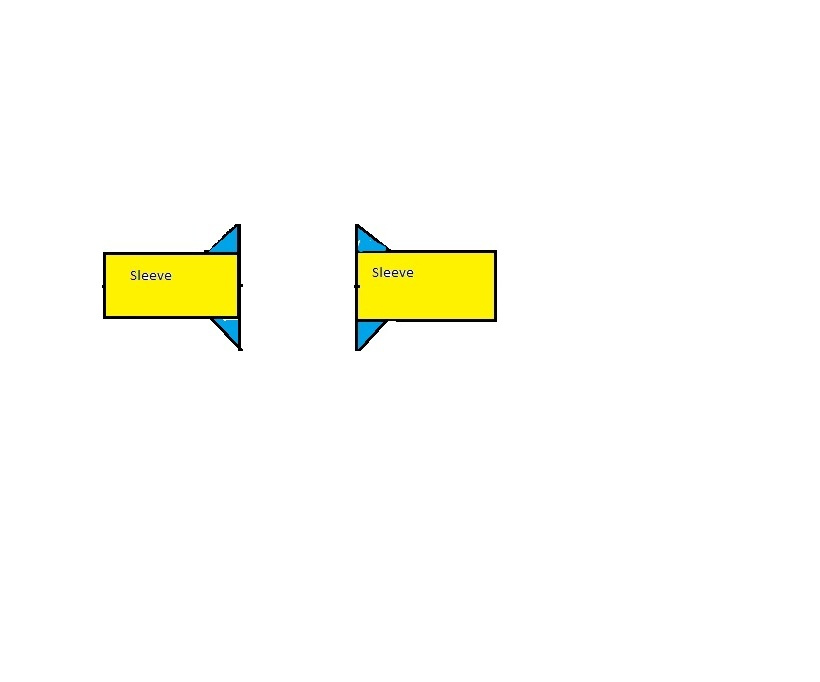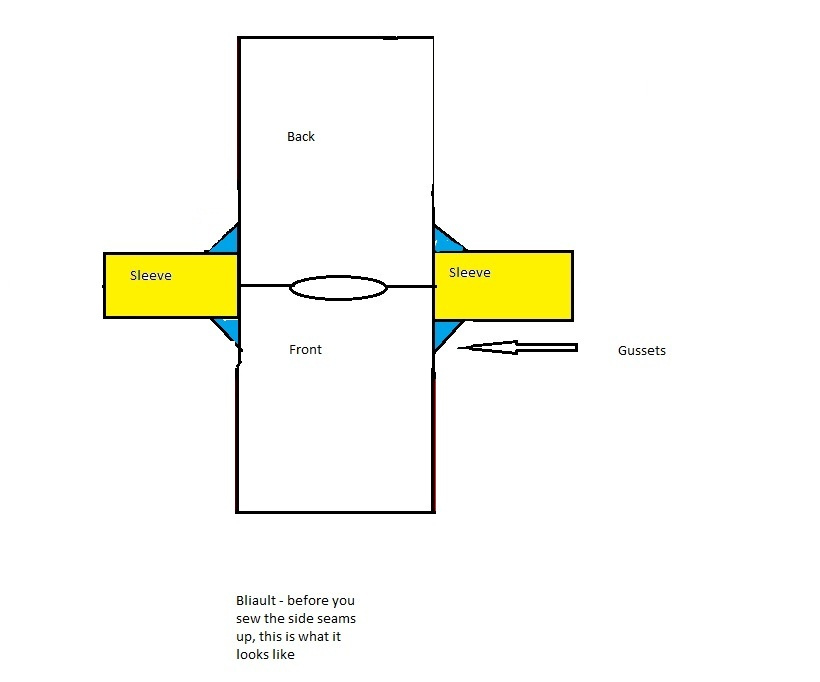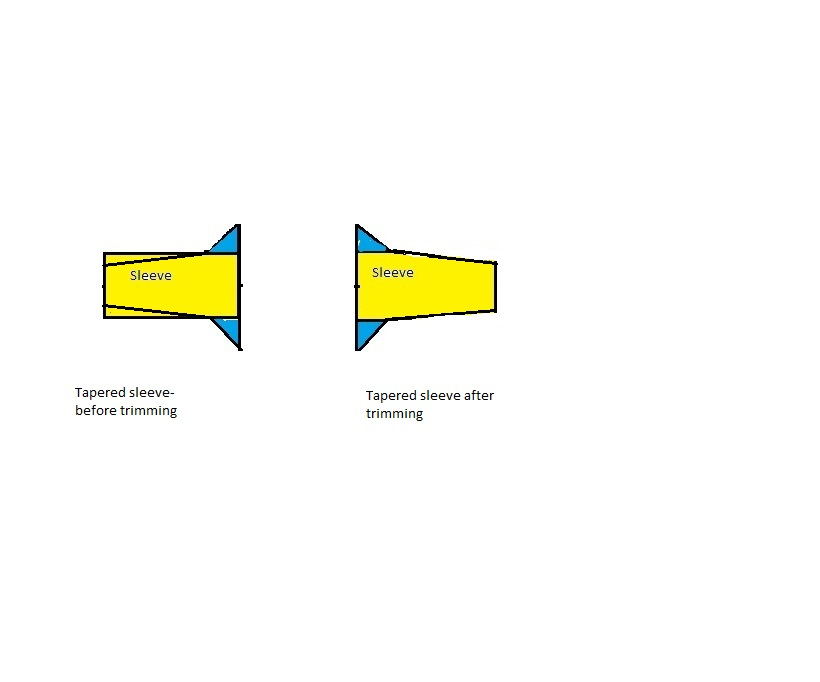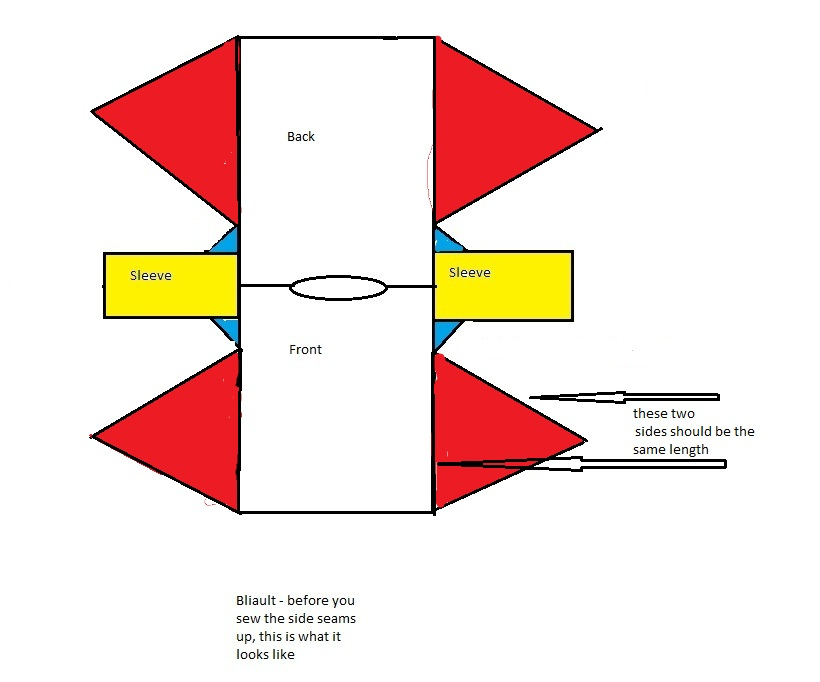How to - Make a simple tunic
How to make T - Tunic
Every outfit needs a foundation, and here's a tunic that's a great place to start. Even though we're not re-enactors, it's basically historically accurate, and has several nice practical features. All you need to be able to do is thread a sewing machine and sew a straight line - you could even do this with handsewing, though it might take a while. The measurements supplied are for a garment which will fit up to a relatively large man (44in chest) but as it's an unfitted garment it will work on people a lot smaller - just shorten the arms.
TIP: If you'd like a more personalised fit, measure across your shoulders from one edge to the other, add an inch and use this for the width of your front and back pieces (you might want to check that it is larger than half of your chest measurement +3 inches - otherwise use the larger of the two measurements). For the arm length, measure from the edge of your shoulder to the bone at your wrist, and add an inch. Always err on the side of largeness - you can always trim it down.
You will need
- 2.5m of fabric which is 60 inches wide. We suggest linen, as it's comfortable, cool in summer and warm in winter, reasonably cheap and looks fantastic.
- Thread in a matching or darker colour. (TIP: if you think you might dye the garment later, get cotton or silk thread. Normal sewing thread won't dye and you'll end up with visible stitching. Coats cotton thread is very good. Guterman quilting cotton thread is too coarse.)
- A tape measure
- A pen
- An iron
Total cost - about £13. You should be able to get linen for £3-6 per metre (try ebay). Shown with a charity shop belt (£2.75)
First - take a look at this picture:
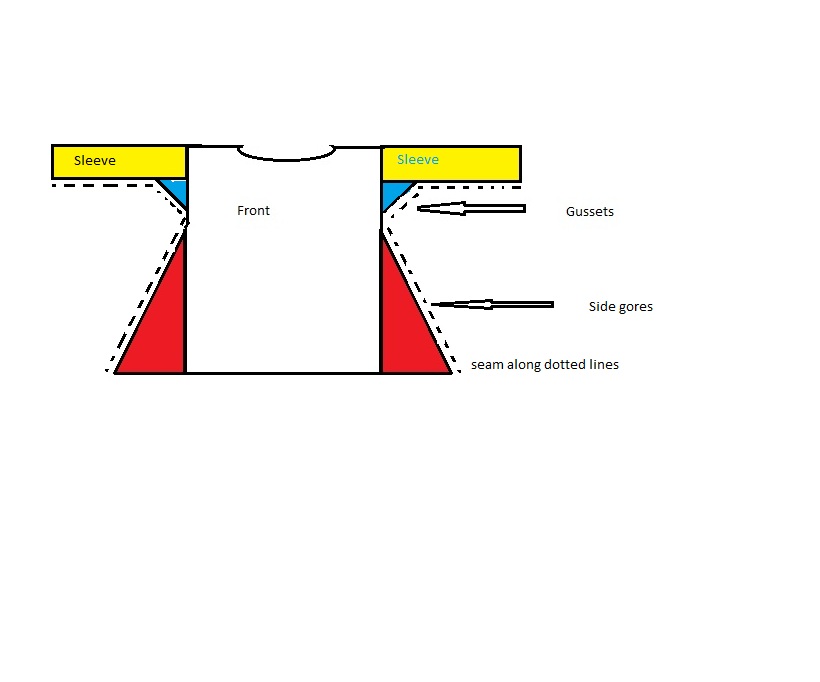
This is basically what your bliaut looks like, laid flat, from the front. Looks like a T shirt, right? The body is a big rectangle, as are the sleeves. The little blue bits under the arms are triangles of fabric called gussets, which act to give you a little bit of room under your arms for comfort and movement, and take the stress off the seams at that point. The red triangles are called gores - they're sewn on to the straight piece to give leg room.
This is how it looks before you sew up the side seams:
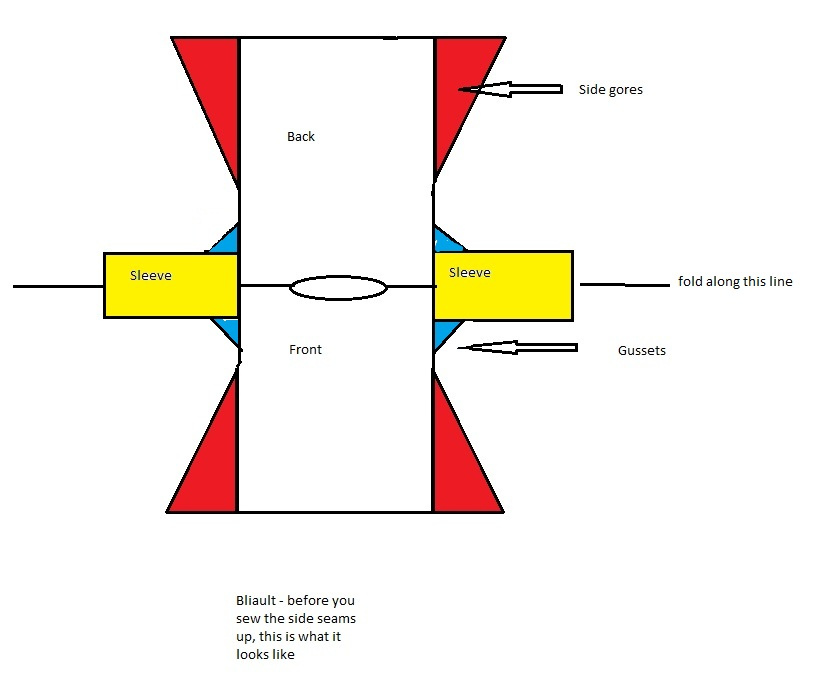
Looks fiddly! Why can't I just cut that shape in one piece?
The answer is that there's no reason why not. In fact, you can find specific instructions on just how to do that here: http://tutorials.abbott.me.uk/odyssey/rome
The trouble with the one piece construction method is that you waste a lot of fabric, and if you're big you'll find the sleeves too short. Historically, loom width was far less than the width of modern fabric, so they invented ingenious solutions like pieceing the garment to save money when fabric was expensive and labour was cheap. But try it this way - the underarms are more comfortable and hard wearing, and you'll save fabric and money.
Ok. But why do I need an iron?
You'll get a much better result if you press your seams at every step. Once you've sewn a seam, put it on the ironing board and press it open - it will look like this:
You can sew several seams then press them open, but a good rule is don't sew across a seam until you've pressed it. Feel free to ignore this bit if it's too complex or you can't be bothered, but I guarantee it'll improve your final result.
Cutting out the pieces
- The Fronts (white): Cut two pieces measuring 25inches by 42 inches
- The Sleeves (yellow): Cut two pieces measuring about 18 inches by 25 inches
- The gussets (blue): cut four pieces which are right angled triangles with the two short sides measuring 6 inches (in essence, cut two 6x6 squares then cut them in half along the hypotenuse, like a posh sandwich)
- The gores (red): cut four right angled triangles, about 24 inches long by 14 inches wide.
Here is a possible cutting layout for 60 inch wide fabric - if you do it this way you should get your garment cut out of 2.1m of fabric, but it's always best to have a bit spare for cockups.
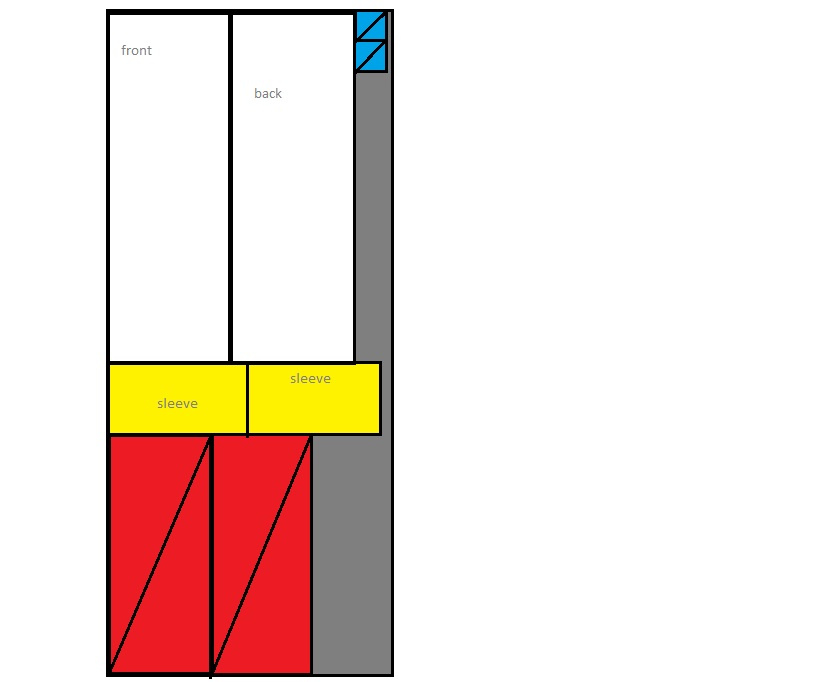
Putting it together
The best place to start is sewing the front to the back along one of the short edges. Cut the neckhole by cutting a shallow scoop shape, like in the diagram, about 8 inches across and about 2 inches deep - start small, you can always enlarge it later. Now, fold the sleeves in half along the SHORT edge, and mark the centre point on both. Sew your gussets on to the sides of your sleeves - they should look like this:
Match the mark you made to the shoulder seam on each side, and sew the sleeves to the body pieces (front and back). It should look like this:
Optional extra step
If you omit this step, you'll have a perfectly wearable garment, but it will have quite wide sleeves. That's fine if that's the look you're going for, or if you're planning on tucking them into vambraces. If you want a neater look, you'll need to taper the sleeves. This is dead easy.
After you've sewn the gussets on, but before you sew the sleeves onto the body, lay your sleeves out flat. The edge without the gussets is the end that's going to be at your wrist. Fold the sleeve in half down its length, and measure out five inches from the folded edge at the wrist, then mark that point on both sides of the folded cloth. When you unfold it, you'll have two marks which are ten inches apart, centred on the mid point. Draw one line from each of these points to connect to where the gusset meets the sleeve at the other end, then trim off the excess cloth. This sounds clunky - the picture shows it much better:
So you see you've now got a nicely tapered cuff. If you want the wrist to be tighter or baggier, just increase or decrease the width of the fabric at the cuff end.
Now sew in the gores. TIP: start from the bottom edge and sew up. Now if you lay it flat, we're back to this picture:

Now all you do is fold it in half along the line in the drawing, and sew along the dotted lines, like so:

Hem the cuff and the lower edge - you can do this by hand or by machine, either is fine.
To finish the neckline, you can turn the raw edge inside and hem it by hand. Check your head goes through the hole before you start!Or, to make it neater, use bias tape. You can read a short article on how to do that here (Part A - how to make a nice curved neckline on your garment). http://tutorials.abbott.me.uk/home/bias-tape
And there it is! Done! You've made your very own historically accurate tunic. Belt it, add your trousers and you're good to go.
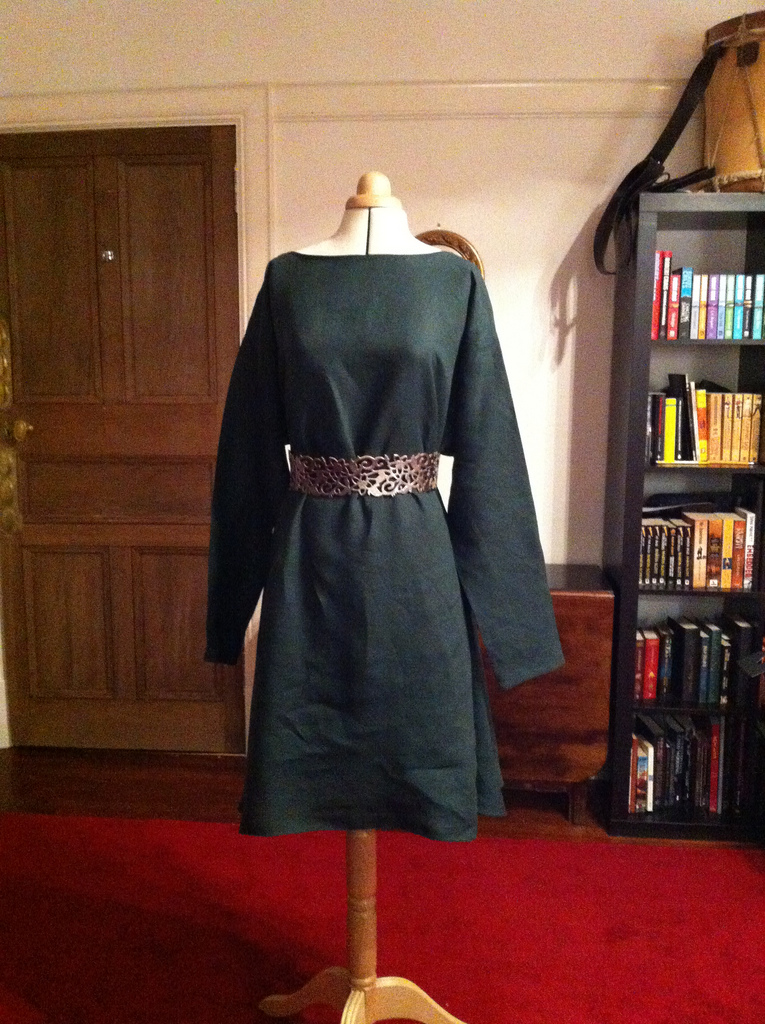
What else can I do with this pattern?
- Try making it longer, for a robe or dress. Make the sleeves elbow length for a different look.
- You can make it in different colours and materials for different nations - black or white for Highguard, bright heraldic colours for Dawn, a nice muted natural brown for the Marches.
- You can make the skirts much wider by making wider gores. However, if you do, you should change the shape of the gores from right angled triangles to isocelese triangles, otherwise the sides of your bliaut will be much longer than the front and back. The pictures shows how:
Hungry for more?
Why not learn How to - Make a surcote?
Want something simpler?
It doesn't get easier than the one piece tunic on the Roman kit making page here
